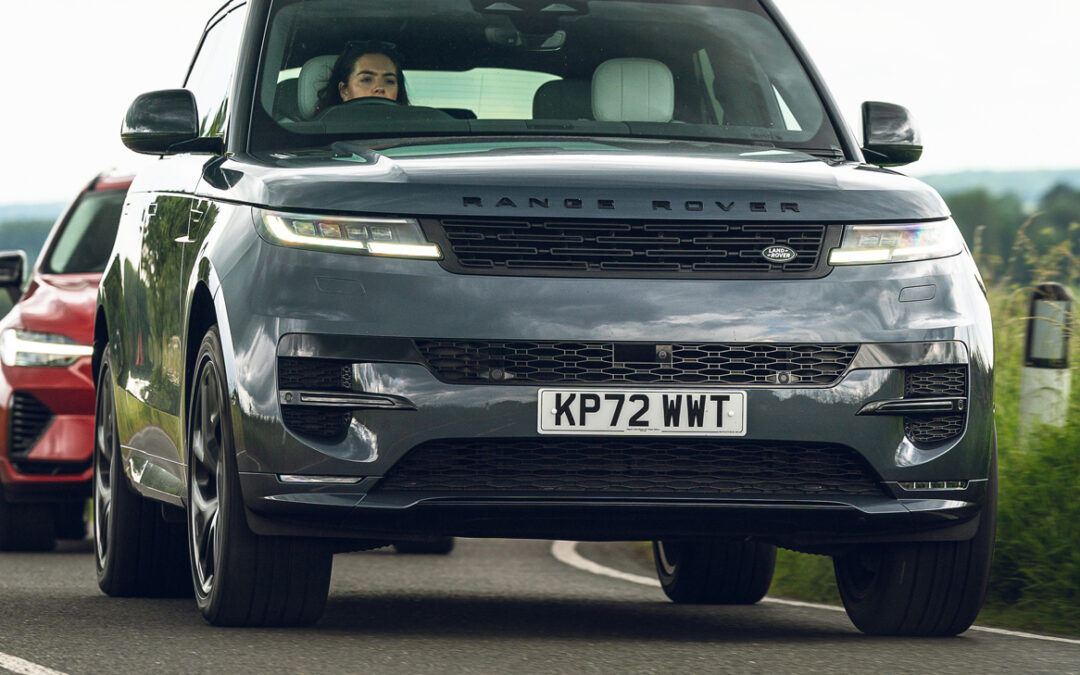
THE GIANT TEST
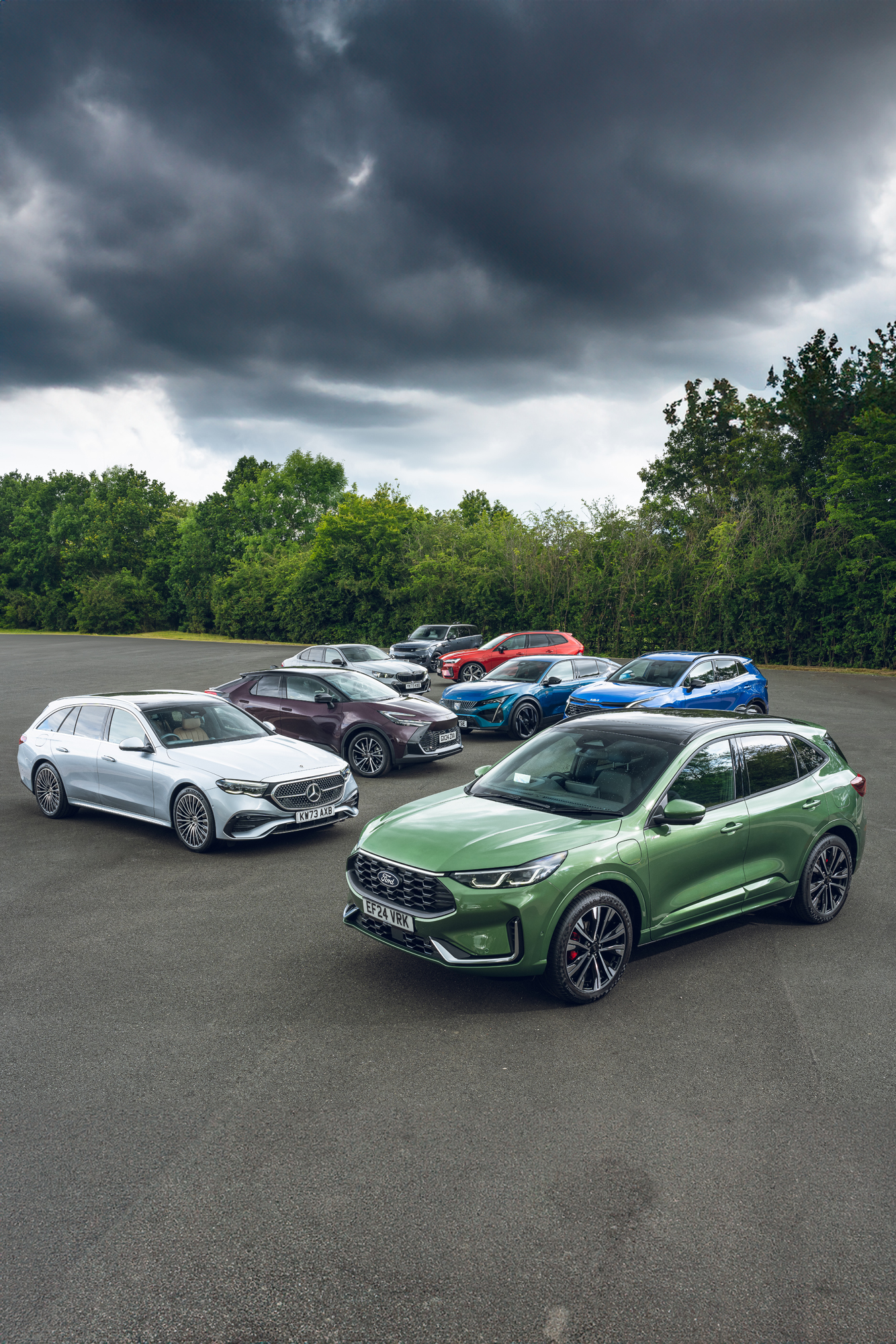
THE GREAT BIG PHEV GROUP TEST
Don’t fancy electric? These plug-in hybrid family cars make a lot of sense. But which is right for you?
WHY TEST THESE CARS NOW?
A decade ago PHEVs were nearly always so compromised that they only made sense to a few people in certain circumstances. But now, in 2024, that’s flipped around. There’s been so much improvement across the board that very often a PHEV is the smart family choice.
That said, there are still plenty of reasons to be dubious about plug-in hybrids – not least because the official mpg figures are the result of a process so convoluted and unrelated to the real world that they are ludicrous. That’s why one of our missions here is to provide plausible economy figures that might actually be repeatable in your life.
Not wishing to bore you with the details of our methodology, put simply the idea is that as well as driving the cars in their ‘hybrid’ modes, with engine and battery working together, we also see how far they will go on battery power alone, from full to empty, and we test the consumption of the engine when it’s having to propel the car on its own, unaided by electric motors.
I can see why you might hold the view that a plug-in hybrid is a cynical tax dodge, rather than a clever ‘best of both worlds’ compromise or stepping stone to full electric. But in a busy decade of car testing, I’ve experienced for myself the rapid improvement of the plug-in hybrid. I used to expect glacial acceleration in electric mode, 20 miles of range if I was lucky, and prodigious thirst when running on petrol. These days, many PHEVs will complete my 40-mile commute at a decent speed without bothering the engine once.
To examine how far we’ve come, I’ve assembled eight family-friendly plug-in hybrids not just from different manufacturers, but from completely different automotive conglomerates – one from the BMW Group, one from Stellantis, and so on.
As well as the overall eight-car tussle for supremacy, there are four fights-within-a-fight going on, as each car has a direct rival. With range, efficiency, performance, price and practicality all weighed up, we’ll crown the winners of those duels and then the overall best family PHEV.
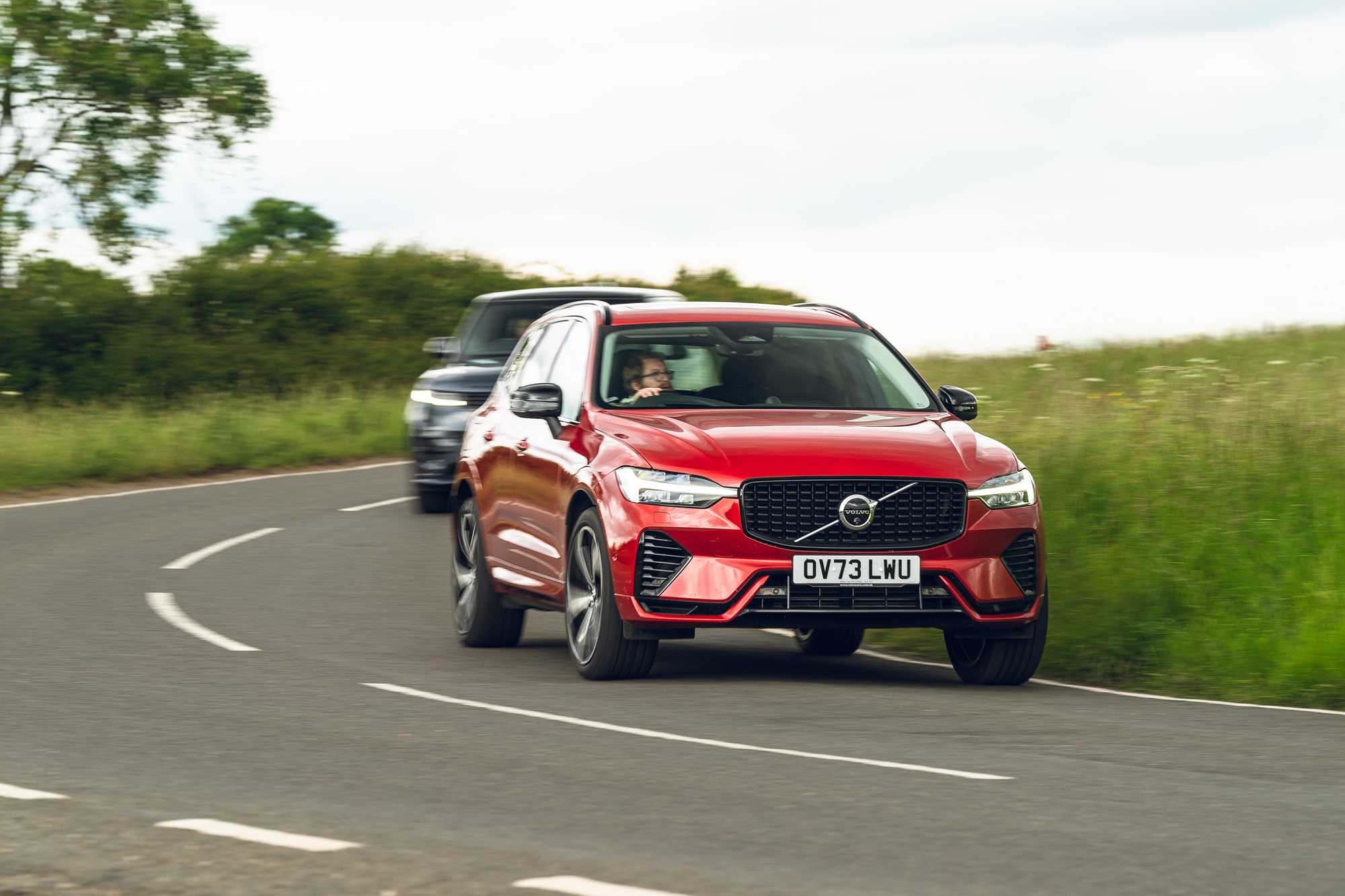
MEET THE CONTESTANTS
Up first is a very traditional dust-up between BMW and Mercedes, 5-series versus E-Class. Our BMW is the 550e saloon, while the Merc is the E300e estate. Six-cylinder saloon against four-cylinder estate might sound a mismatch, but they’re actually not far apart on price, and both claim good electric-only range. And in any case, the 550e is available only as a saloon; the PHEV estate is the weedier/more sensible 530e.
Then we have a couple of traditional, unflashy compact family SUVs. The Kia Sportage is one of the UK’s best-selling cars, while the Ford Kuga has just received a midlife facelift. Both are far more attainable than BMW and Merc, and should offer better economy from their smaller engines.
If you like the raised ride height of an SUV but prefer the looks of a coupe-style roofline, two cars aimed at you are the Peugeot 408 and the new version of the Toyota C-HR.
The line-up is completed by two relatively swish, large and expensive SUVs. The Volvo XC60 has been around since 2008, and in its earliest incarnation was one of those compromised vehicles that gave PHEVs a bad name. The PHEV on sale now, by contrast, has a bigger battery and better electric motor, among many other evolutionary changes.
But the Volvo won’t have an easy ride, as it’s up against one of the PHEVs currently promising a remarkably long electric range. The Range Rover Sport, here in P440e guise, is by far the most expensive car here, in exchange for which you get a very classy package as well as those green claims.
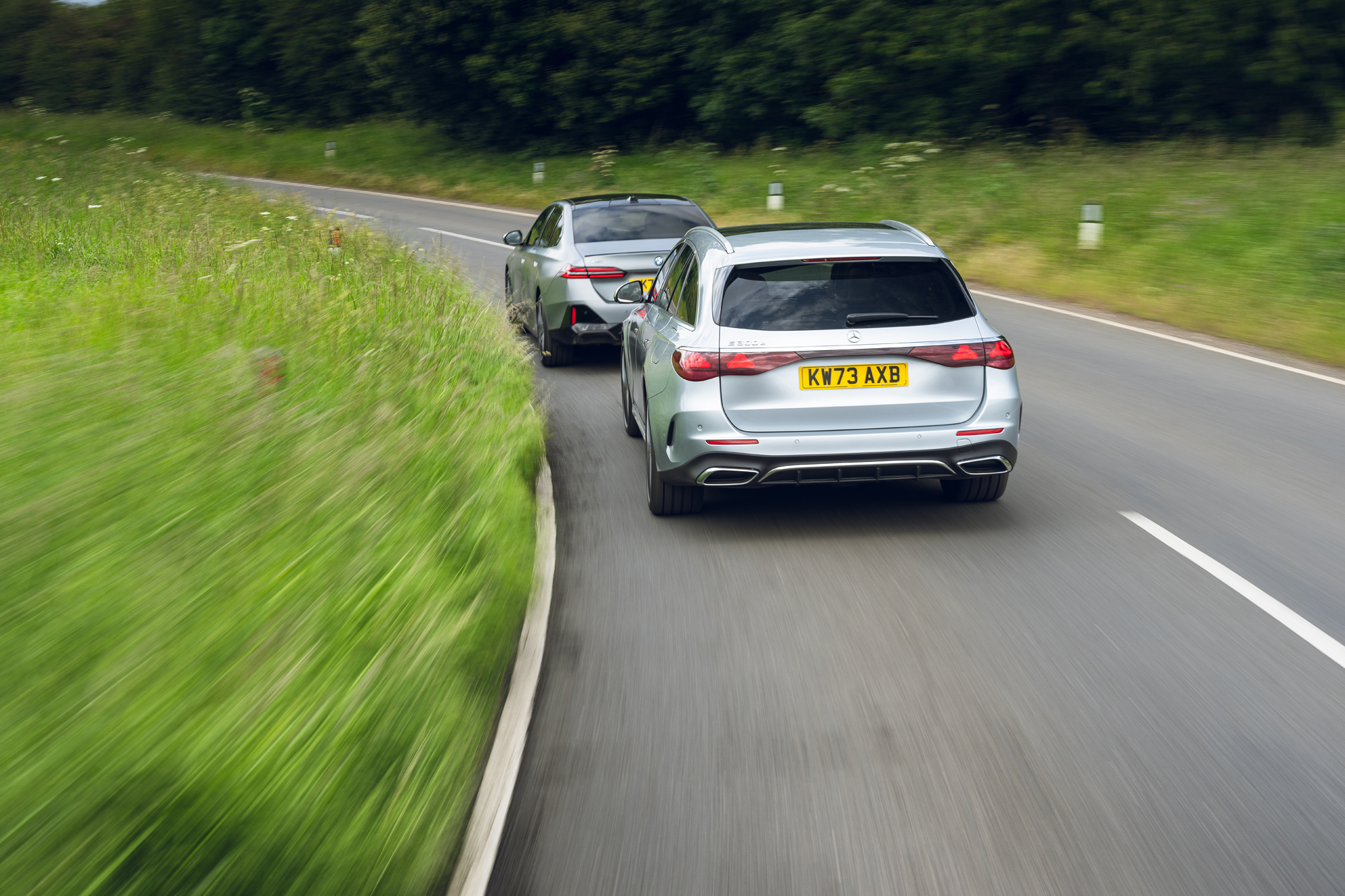
ROUND ONE: THE PREMIUM GERMANS
Setting aside considerations of economy for a moment, let’s talk about luggage space. You’d assume that the Merc, being an estate, would dwarf the BMW’s carrying capacity. But there’s in fact a pleasant surprise from the BMW. Clever battery packaging means the 550e has a 520-litre boot – the same as a 5-series with a conventional (non-PHEV) combustion engined. A folded pushchair and a week’s worth of shopping will fit easily.
By contrast, the Merc’s big battery pack requires the E300e to come with a higher boot floor than its non-hybrid alternatives. That reduces carrying capacity (measured up to the parcel shelf) at 460 litres, rather than the 600-plus it would otherwise be.
That said, the parcel shelf is easily removed, thus liberating much more capacity, whereas the traditional saloon car’s bootlid means 520 litres is as much as the BMW can manage.
Giving the E-Class a further advantage on practicality, it also has more rear headroom than the BMW and similar legroom.
With a full battery it managed an impressive 54.7 miles until it was forced to switch to petrol power
In keeping with the usual pattern of these 5/E clashes, the BMW feels the more dynamic, faster car. Rear-wheel steering and adaptive dampers, both fitted as standard, help mask the car’s bulk, allowing you to really press on and enjoy the rear-biased four-wheel drive and that engine. The noise is a bit synthetic, although better than the sound of the four-cylinder E-Class engine. Both have smooth hybrid systems, although the E-Class’s brake feel isn’t as reassuring as the BMW’s.
A soft suspension set-up highlights that this Merc is a wagon built for comfort, although it can still be caught out by sharp ruts and potholes in a way the 5-series isn’t. Rear air suspension is standard, but you can’t have full air suspension and rear steer on plug-in versions of the E-Class. It’s a shame, as it lifts the ride from acceptable to cushiony, and sharpens up the handling in the sportier driving modes.
Efficiency is better in the Mercedes. With a full battery it managed an impressive 54.7 miles until it was forced to switch to petrol power. The 550e falls more than 10 miles short of the Merc, but in most comparisons its 44.6-mile electric range would still be impressive. (The 530e, which is lighter – not least because it has rear- rather than all-wheel drive – gets far closer to the E’s figure.)
When the test turns to engine-only running, the BMW’s 35.8mpg is beaten by the Merc’s 40.2mpg. If performance is your priority, that’s not a huge penalty to pay at the pumps considering the far faster acceleration from the significantly bigger engine – but it’s a financial difference that will matter over the course of a year. So it’s victory in this bout for the Mercedes.
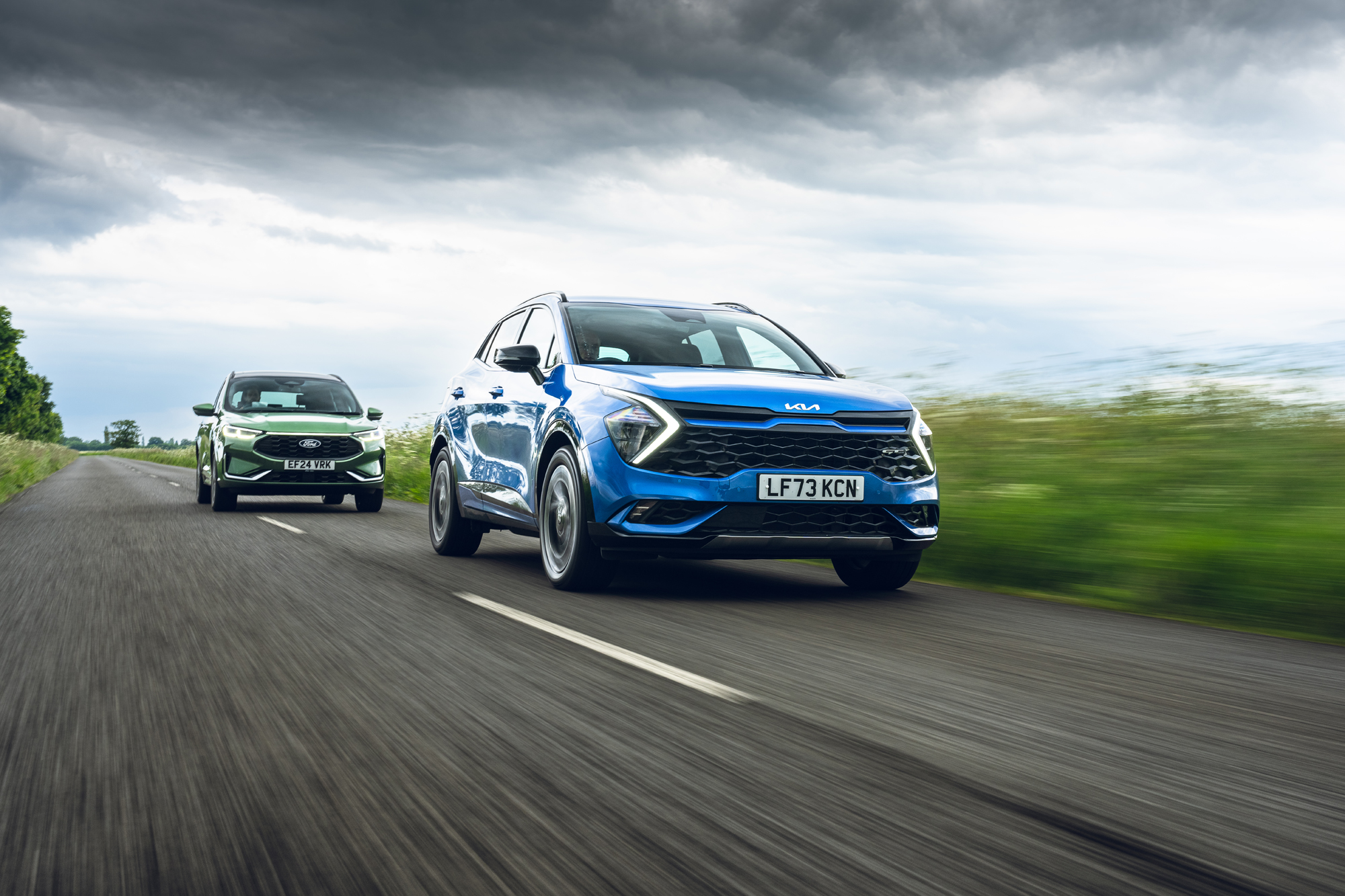
ROUND TWO: COMPACT SUVS
The moment you get into the Kia Sportage, it’s easy to see why it’s one of Britain’s best sellers. Its interior looks and feels more expensive and appealing that the recently facelifted Kuga’s. Ford is stingier with the soft-touch materials and metal-effect trim pieces, and the heater controls have now annoyingly migrated into the touchscreen. Those things matter, and it’s a comparison that will happen in showrooms around Britain and beyond every day.
In both cars there’s plenty of space up front for tall adults, with the Kuga slightly ahead for rear legroom when the sliding bench is in its rearmost position. Headroom is similar for both in the back, with panoramic sunroofs eating into that space – something to avoid if you’ve tall friends or giant teenager passengers.
Plug-in hybrid Sportages get a very respectable 540 litres of boot space. That’s way more than the Kuga’s 412 litres. But slide the Ford’s bench forward and this increases to 553 litres at the expense of rear legroom. Sportages get a usefully versatile 40/20/40 split folding rear seat, with the Kuga making do with a 60/40 split.
However, the Sportage’s advantage disappears as soon as you hit the road. In electric mode you’re aware of automatic gearchanges, and it gets even worse when the engine fires. The hybrid system is sluggish to respond, jerky and generally a bit of a disappointment. The chassis could also do with a bit more polish. It’s comfy enough, but the steering is vague, and it doesn’t feel agile in the bends.
Acceleration is usefully perkier, with less hesitation from the CVT gearbox
The Kuga is so much better to drive, in keeping with Ford’s reputation for good dynamics on even the least sporty of cars. The ride quality is noticeably firmer than the Sportage, with tight body control and much better damping making sure it’s still comfy enough. Even in a straight line you notice the steering is far more precise and needs fewer corrections, while the powertrain is so much more refined.
Acceleration is usefully perkier, with less hesitation from the CVT gearbox, although if you’re trying to get a move on by pressing your foot to the floor, an unpleasant side effect if the noisy droning of an engine staying at constant revs.
Kia avoided this by opting for a dual-clutch automatic transmission, but in practice the shifts are never as smooth or swift as you’d hope. On the whole, in normal driving, the Kuga’s acceleration is seamless and quiet, making for a preferable overall experience.
And the Ford can be fun on twisty roads. There’s better feedback for the driver, with a greater sense of connection, and a more neutral feel to the car’s balance during cornering. It doesn’t lean as much as a typical SUV – it’s more like a hatchback – so a cross-country blast can be rather entertaining.
Bearing in mind that the Ford and Kia are relatively reasonably priced, it’s no surprise they have smaller batteries and a shorter electric driving range than the more upmarket alternatives. Second worst of the eight cars on test for range is the Kuga at 30.5 miles, although the engine’s economy is an impressive 50.1mpg. The Sportage fares slightly better in clean running at 33.3 miles; the engine, on its own, returns a respectable 40.9mpg.
The Kia has plenty in its favour, but the superior driving experience is decisive: the Ford wins this pairing.
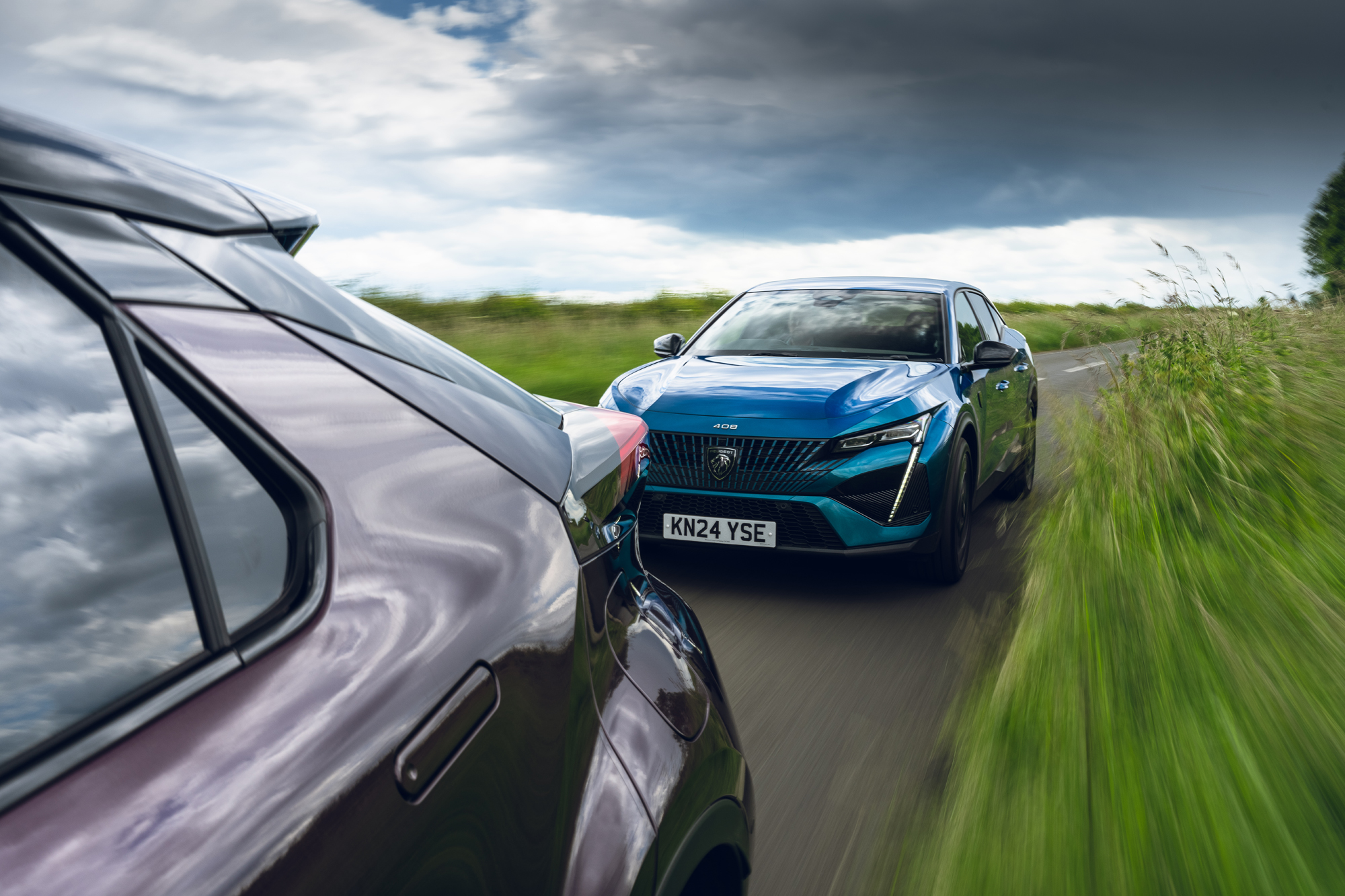
ROUND THREE: CROSSOVERS WITH ATTITUDE
In theory the smaller, more slippery coupe-SUVs should be even more frugal than the regular SUVs, and one of them most certainly does. The Toyota C-HR’s 53.8mpg during engine-only driving is the best on test, and the 36.1-mile electric range is top among the cheaper, smaller-batteried cars here. By contrast, the Peugeot 408 manages just 26 miles on a charge, and an okay-but-not-great 40.3mpg with a flat battery – figures that reinforce the idea that the Stellantis group’s plug-in hybrid system is most definitely off the pace these days.
That said, the 225 Hybrid system is nowhere used better than here in the 408. There’s less vibration and a more polished feel to how it switches between petrol and electric compared to other cars with this powertrain. The engine is, however, oddly unwilling when pushed, and it can’t match the slickness of Toyota’s system, which is less prone to mooing when flat-out than the Kuga, and is more responsive and a little quicker than the 408.
Like the Toyota, the Peugeot has a dark interior, but it benefits from having more glass, and generally more room
For all its weaknesses, the Peugeot is better to drive than the Toyota. Where the 408 has a supple ride quality that you don’t expect when you see such large wheels, the C-HR feels significantly stiffer. In some cars that stiffness is worth it because it gives better control through the bends, but not here; the Toyota leans a surprising amount and just doesn’t feel as keen as you’d hope.
The C-HR steers inoffensively enough, with a not particularly quick rack but decent precision. The trouble is that it always feels like a heavier, taller car than it is, and one that just doesn’t want to be hustled. The 408 isn’t massively more exciting, but its quicker steering rack and flatter cornering angles make it feel that bit more willing to cover ground briskly, despite being the softer, comfier choice.
Viewed as family transport, the Toyota is again second best. The shape of its rear may look stylish from the outside, but it creates a small glass area and thick rear pillars that bring a claustrophobic feel and a poor view out for children. There’s also not a great deal of head- or legroom, although to be fair it is one of the smaller cars here.
Like the Toyota, the Peugeot has a dark interior, but it benefits from having more glass, and generally more room. Its 454-litre boot is vastly preferable to the C-HR’s piddly 310-litre effort. Given that the Peugeot also feels significantly plusher inside, we have to give the nod to the 408.
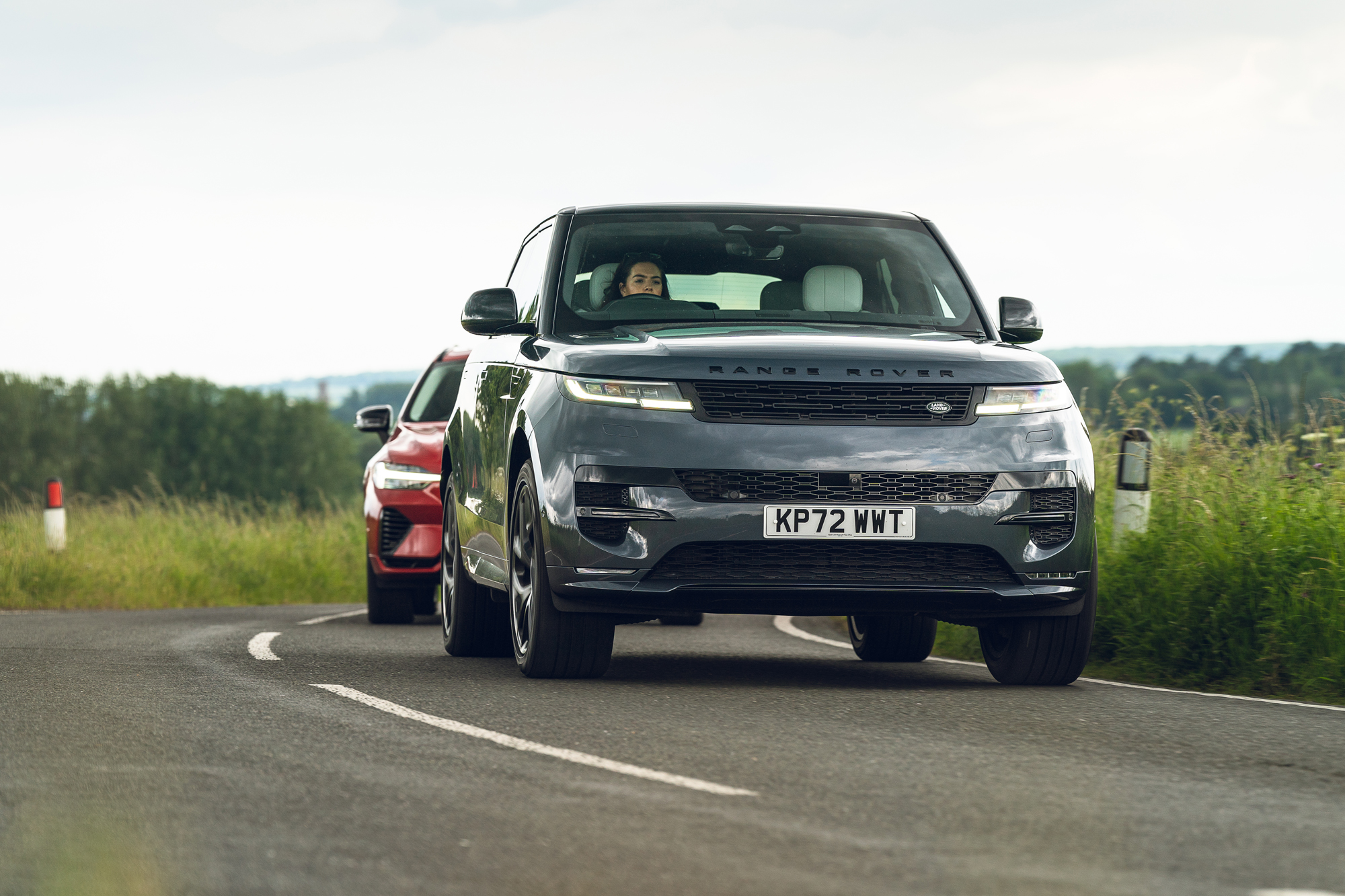
ROUND FOUR: THE BIGGER HITTERS
The Range Rover Sport is a fair bit bigger and more expensive than the Volvo XC60 but both are sportier-looking five-seat SUVs playing little brother to more stately older siblings – the Range Rover and XC90/EX90 respectively. Neither feels remotely cramped up front and there’s a multitude of electric adjustments to allow all heights to get comfortable.
Move to row two, and the Sport feels that bit bigger, although the XC60 is by no means stingy, with enough space for those over 6ft tall, and the option of clever integrated booster seats. Three will be happier in the Sport thanks to its flat floor and wider cabin, though.
A 483-litre boot is perfectly serviceable for many families but the XC60 can’t come close to the usefulness of the Sport’s 647-litre cavern. Both get handy load separators that pop out of the floor, with the Sport’s 40/20/40-split folding and electrically reclining rear bench beating the XC60’s plain 60/40 split.
It’s astonishing how much lighter it feels than it really is
Quality impresses in both, with a finish that seems appropriate for their prices. Both go for a minimalist aesthetic with not many buttons and touchscreens that have to control almost everything. Volvo’s Google-based system is fine to use, but the 9.0-inch screen seems tiny and it’s not as simple as Land Rover’s more attractive and responsive unit.
Given that the XC60 has a 2.0-litre four-cylinder engine and the Sport a 3.0-litre inline-six, it’s a surprise to find the former is faster; credit to its lower weight and greater output. However, it’s the Sport that feels happier to deploy its power, all of it channeled through all four wheels. In the XC60, the engine drives the front wheels and the electric motor the rears, leading to a bit of torque steer.
Similarly, the XC60 always feels more front-biased in bends, with the Sport exhibiting a more neutral to rear-led balance accelerating hard out of a corner. It’s astonishing how much lighter it feels than it really is on account of clever air springs, adaptive dampers and rear-wheel steering. It’s also very comfortable, and feels more relaxed and less sudden when dealing with bumpy roads than the XC60.
A big jump in battery capacity has really helped the XC60, yet its 14.7kWh pack is a tiddler compared to the giant 31.8kWh in the Sport. The Range Rover clocks an impressive 51.2 miles on the battery.
You won’t get nearly as far in the XC60 – although its maximum in our test of 37 miles would have been impressive a couple of years ago, such is the rate of improvement. Flat-battery economy is improved from the 28mpg the early cars managed; 33mpg is palatable for a big petrol SUV, especially one with such a turn of speed.
We had high hopes for the Sport based on a near-31mpg performance from the bigger, heavier and less aerodynamic Range Rover. Disappointingly, we managed only 26.9mpg. I should point out that the P440e has been replaced with a more efficient and powerful P460e. If you’re buying used, make sure you know which you’re getting.
The electric motor gets a boost in power and efficiency in the 460, which should help the petrol engine stay idle longer in hybrid mode. It’ll also perk up the rather sluggish performance in electric mode. Like the P440e, it sits in a five per cent BiK tax rating, making for a temptingly low monthly payment for company car drivers. It’s enough to tip victory in the Land Rover’s direction.
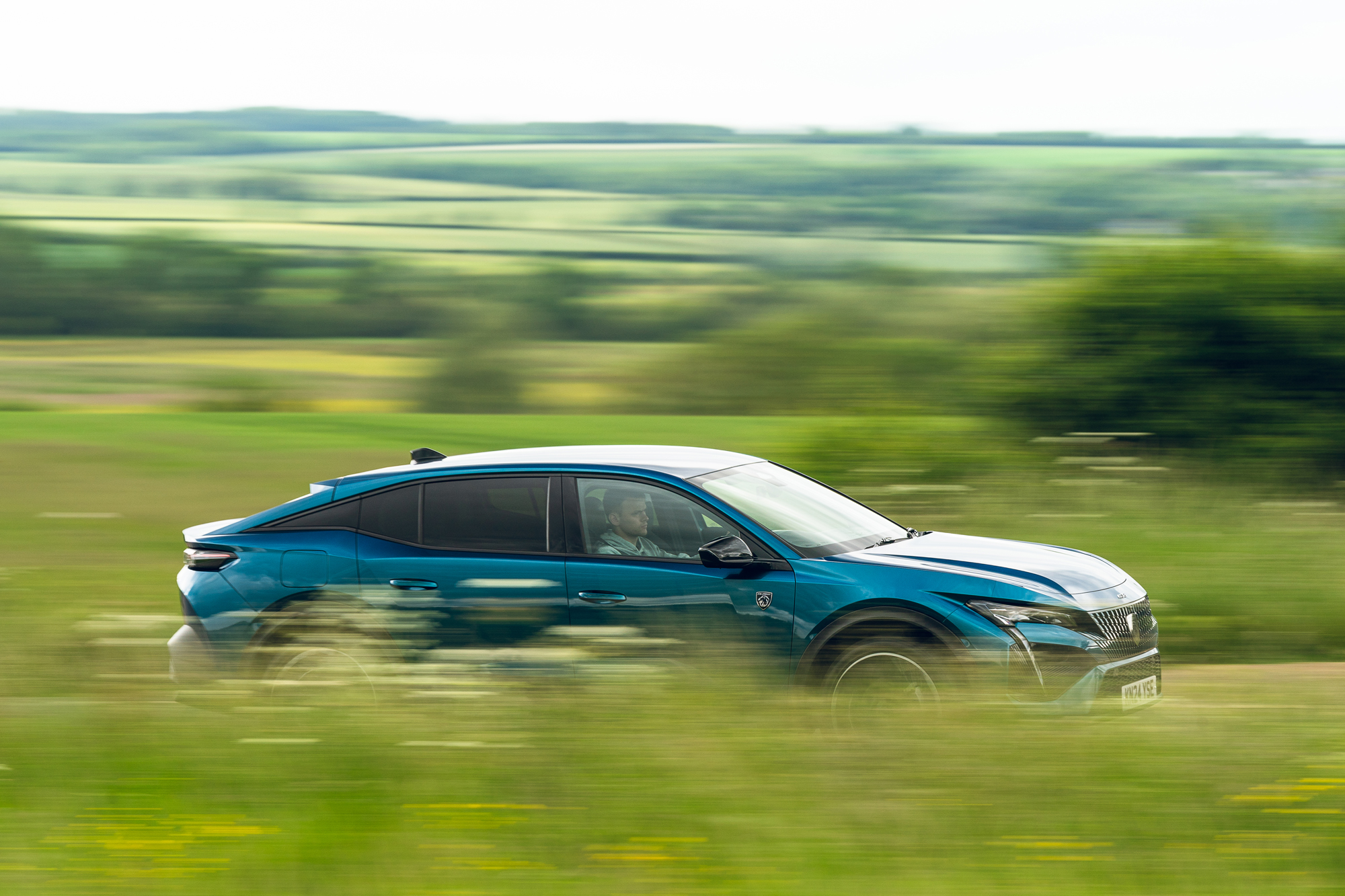
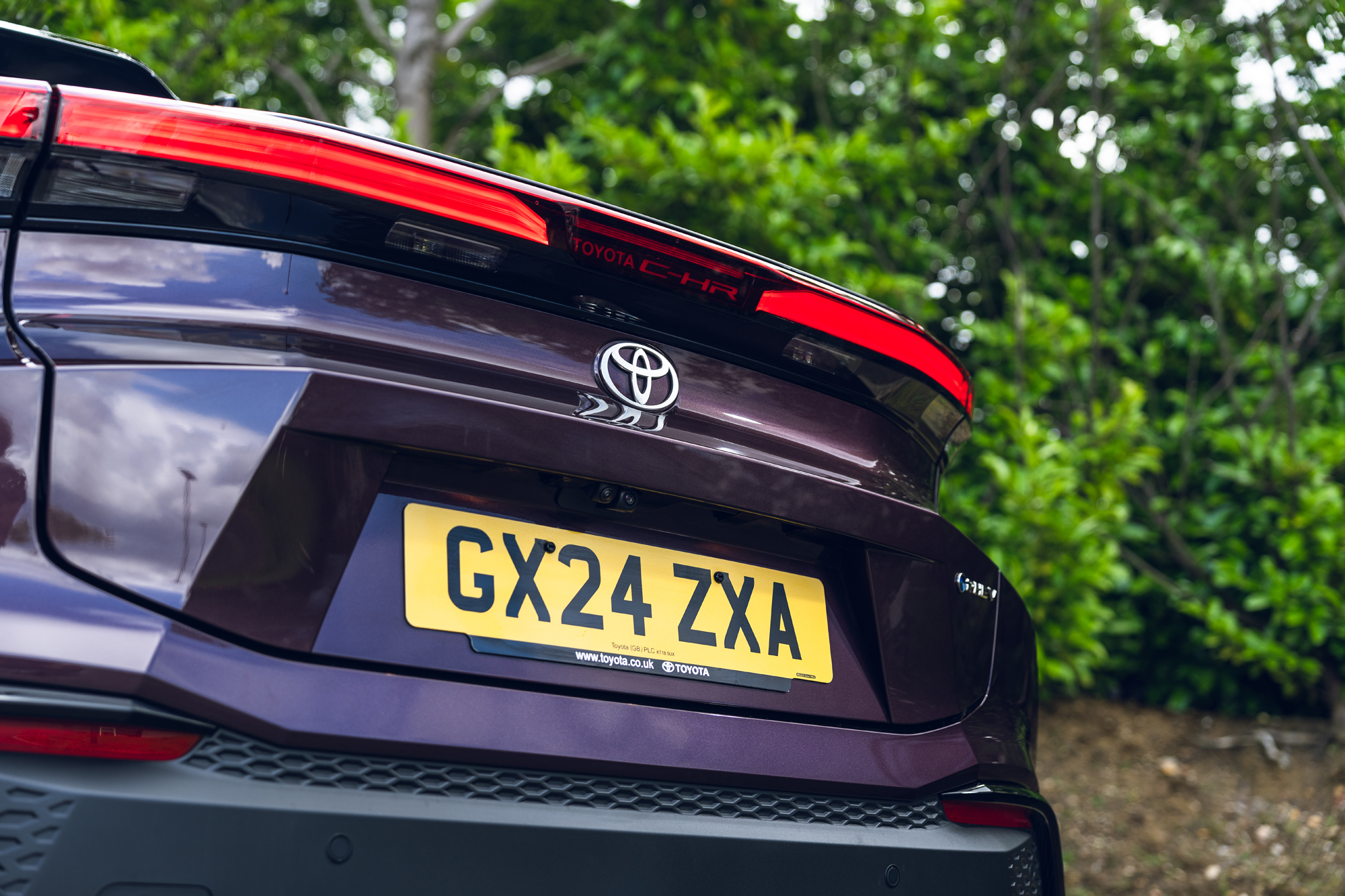

The Final Reckoning
FOUR WINNERS, ONE CHAMPION
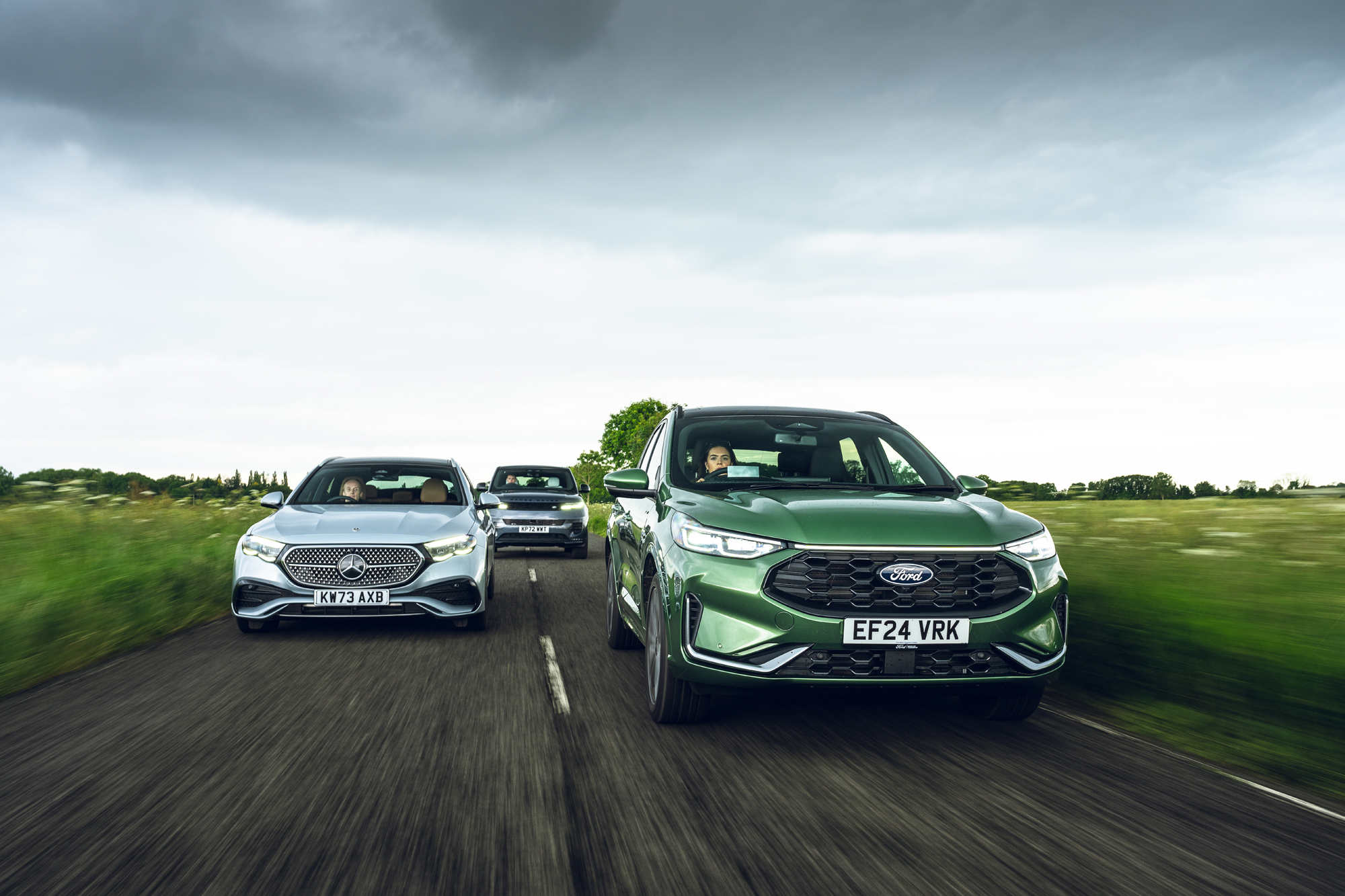
As promised, we’re whittling the original eight down to four – one from each pairing – and then selecting our overall favourite. It’s worth stressing, however, that all eight cars have much to commend them, and an owner is unlikely to be disappointed with any of them.
We’ve stayed focused on the aim of identifying the best PHEVs for families. That makes it easy to dismiss the Toyota C-HR. Yes, it’s the most frugal car here, with a polished hybrid system. However, this is a family PHEV test and the C-HR just doesn’t have the boot space or the rear-seat environment. The Kia goes out because its chassis is some way short of greatness. The BMW, while fun, isn’t that practical or frugal. The Volvo is sensible and appealing in many ways, but overshadowed by the Range Rover Sport.
That leaves four class winners: Peugeot 408, Range Rover Sport, Mercedes E-Class and Ford Kuga.
There are lots of reservations, and there’s plenty of room for improvement, but the plus points add up to a clear verdict
And that’s the ascending order we rank them in. The 408 combines practicality and polished driving dynamics, not to mention a far bigger boot and rear quarters that feel less like a prison cell. But 26 miles of electric range is a poor show for a modern PHEV and its petrol consumption is disappointing too.
In third there’s the Range Rover Sport. It’s easily the most spacious car here and has a big boot that’s unaffected in size by going plug-in. Besides, it just makes you and your passengers feel good with its luxurious interior and impressive driving dynamics. That you can have it for such a small BiK payment is quite remarkable, as is its long electric range.
In second overall is the E-Class. It goes even farther than the Range Rover with a smaller, cheaper-to-fill battery and is still plenty big enough for passengers. It’s a shame the boot space is reduced by such a significant amount compared to mild-hybrid E-Classes, but there’s still good space that gets significantly bigger once the load cover is out of the way, let alone with the rear seats folded.
It’s worth dwelling on just how good its hybrid system is. It’s close to the 408 and Sportage on economy, despite being both bigger and quicker. And it doesn’t drive very well ‘for a hybrid’; it drives very well.
But it’s the Ford Kuga that wins the test. There are lots of reservations, and there’s plenty of room for improvement, but the plus points add up to a clear verdict.
The electric range is disappointing; petrol consumption is very good. The interior is a bit dowdy, but it’s roomy. And you can forget just about all its shortcomings when you take it for a spirited drive on a twisting stretch of tarmac. It will make you smile, and won’t punish you with greedy consumption. It’s not perfect, but it is a highly recommendable option for those with a bit of petrol in their veins.
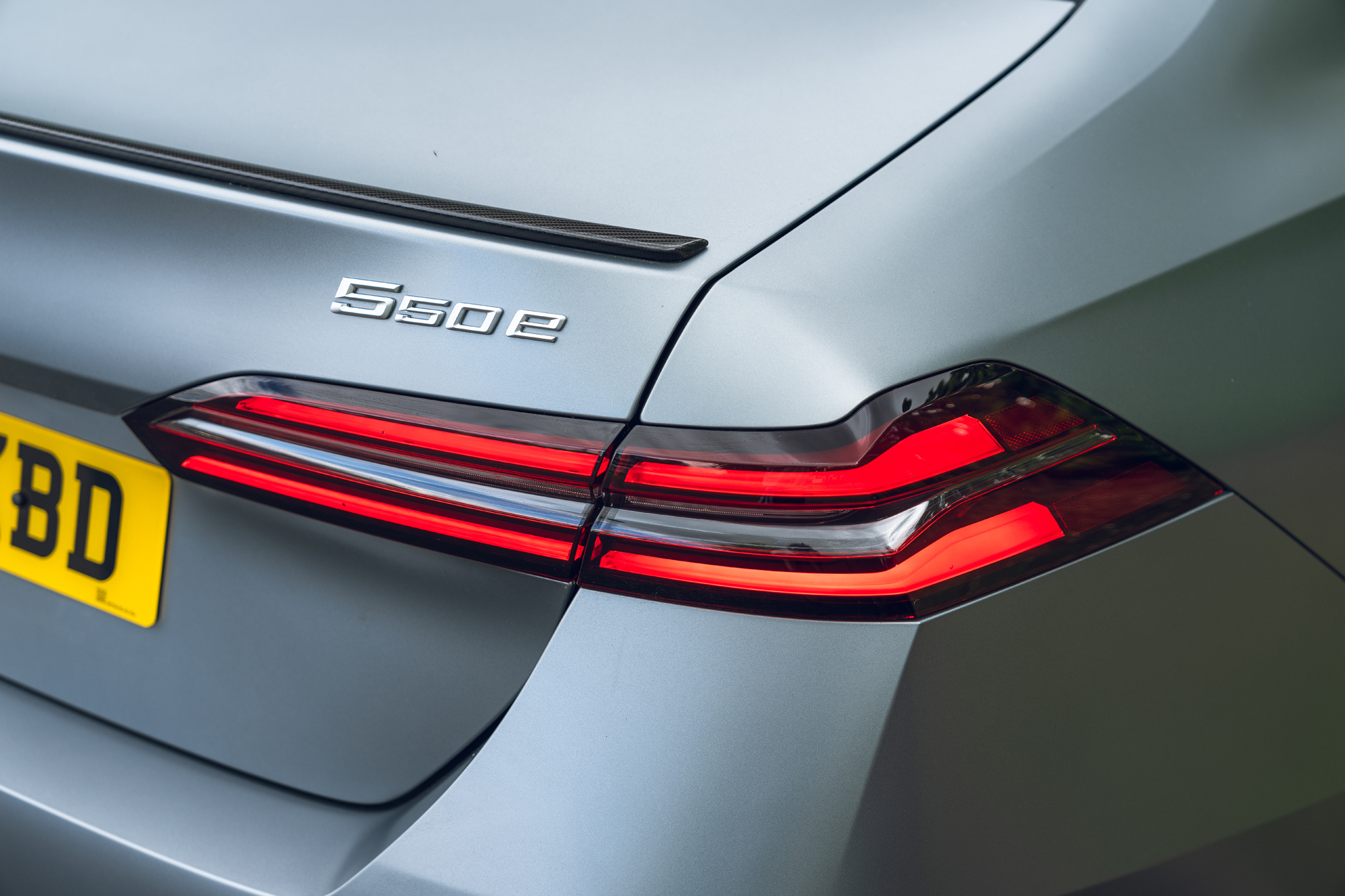
Facts & Figures | BMW 550e
What’s the line-up?
There’s not one but two plug-in hybrids available in the BMW 5-series. The sensible option is the rear-wheel-drive 530e, which combines a 18.7kWh battery pack and 181bhp electric motor with a 2.0-litre petrol engine. We have the 550e, which swaps the four for a six-cylinder and adds all-wheel drive for far more urgent performance. It’s less efficient and far pricier, but you still get a competitive BiK rate and a much more driver-pleasing car.
Data
Price £76,605 (£99,325 as tested)
Engine 2998cc turbocharged six-cylinder
Hybrid system 18.7kWh battery (net), single electric motor, eight-speed automatic
Performance 482bhp (total system output), 516Ib ft (total system output), 4.3sec 0-62mph, 155mph
Weight 2230kg
Claimed efficiency 282.5-353.1mpg, 51-56-mile range, 19-23g/km CO2
Tested efficiency 44.6-mile electric range, 35.8mpg (engine only)
Length/width/height 5060/2156/1515mm
Boot capacity 520 litres

Facts & Figures | Ford Kuga PHEV
What’s the line-up?
A recent facelift for Ford’s family-sized SUV means it’s worth revisiting. The battery size remains the same at 14.4kWh, but tweaks to the hybrid system liberate a bit more power and range. The PHEV is front-wheel-drive only, with only the non-plug-in hybrid getting the option of all-wheel drive. There’s a new, more rugged-looking Active trim, along with sporty ST-Line as seen here.
Data
Price £40,555 (£45,805 as tested)
Engine 2488cc four-cylinder
Hybrid system 14.4kWh battery (net), single electric motor, CVT
Performance 240bhp (total system output), n/a Ib ft, 7.3sec 0-62mph, 124mph
Weight 1859kg
Claimed efficiency 235.4-313.9mpg, 37-43-mile range, 20-28g/km CO2
Tested efficiency 30.5-mile electric range, 50.1mpg (engine only)
Length/width/height 4615/2177/1651mm
Boot capacity 412-553 litres

Facts & Figures | Kia Sportage PHEV
What’s the line-up?
The Sportage PHEV is one of the best-selling cars in the UK, second only to the Ford Puma so far in 2024. All plug-in Sportages are four-wheel drive, with a 13.8kWh battery and a punchy 261bhp total system output. All-electric range isn’t anything spectacular, but it’s competitive among immediate rivals and to be expected for the price. Boot space does shrink if you pick a PHEV over a regular hybrid or combustion-only Sportage, but by far less than most other cars here.
Data
Price £40,575 (£41,225 as tested)
Engine 1598cc turbocharged four-cylinder
Hybrid system 13.8kWh battery (net), single electric motor, six-speed automatic
Performance 261bhp (total system output), 258Ib ft (total system output), 7.9sec 0-62mph, 119mph
Weight 1905kg
Claimed efficiency 252mpg, 43-mile range, 25g/km CO2
Tested efficiency 33.3-mile electric range, 40.9mpg (engine only)
Length/width/height 4515/2080/1650mm
Boot capacity 540 litres
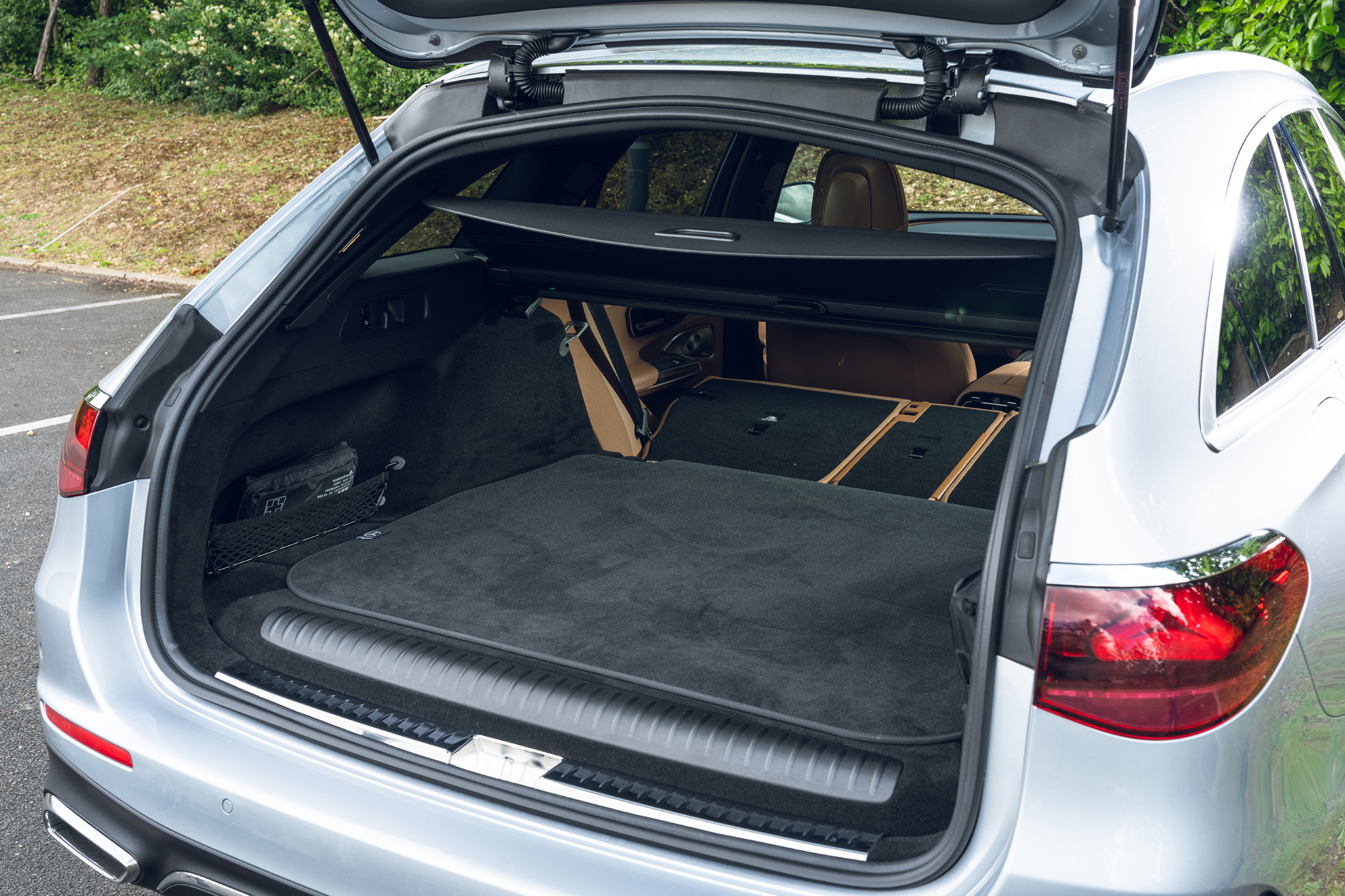
Facts & Figures | Mercedes-Benz E300e Estate
What’s the line-up?
Mercedes has been pushing the boundaries of PHEV electric-only range for a while now, and the E300e carries on the good work. A big battery does mean plenty of intrusion into the boot, though. While a combustion E-Class is one of the most cavernous estates on the market, the plug-in hybrid has less space than a BMW 3-series Touring – that’s one class down. A six-cylinder plug-in hybrid AMG E53 is available and is even spicier than the BMW 550e that’s in this test. There’s a choice of sporty-looking AMG Line trim or more restrained Exclusive.
Data
Price £66,860 (£78,835 as tested)
Engine 1999cc turbocharged four-cylinder
Hybrid system 25.2kWh battery (net), single electric motor, nine-speed automatic
Performance 309bhp (total system output), 406Ib ft(total system output), 6.5sec 0-62mph, 141mph
Weight 2285kg
Claimed efficiency 470.9mpg, 59-69-mile range, 14g/km CO2
Tested efficiency 54.7-mile electric range, 40.2mpg (engine only)
Length/width/height 4950/2065/1472mm
Boot capacity 460 litres

Facts & Figures | Peugeot 408 Hybrid 225
What’s the line-up?
If a Peugeot 3008 is too tall, but a 308 too low, maybe you should try the 408. The four-door coupe-on-stilts approach has certainly resulted in a head-turning car, although you do sacrifice some practicality for those looks. Two PHEVs are offered, the base Hybrid 180 that’s available in Allure or GT trim, or the 225 we have here that’s GT only. They use the same battery and electric motor, but the 225’s petrol engine has a bit more pep. The electric range is the same in both, and it’s the only competitor with an official range of less than 40 miles.
Data
Price £44,720 (£47,510 as tested)
Engine 1598cc turbocharged four-cylinder
Hybrid system 12.4kWh battery (net), single electric motor, eight-speed automatic
Performance 222bhp (total system output), 266Ib ft (total system output), 7.8sec 0-62mph, 145mph
Weight 1706kg
Claimed efficiency 174.5-232.5mpg, 34-mile range, 28-37g/km CO2
Tested efficiency 26-mile electric range, 40.3mpg (engine only)
Length/width/height 4687/2062/1478mm
Boot capacity 454 litres

Facts & Figures | Range Rover Sport P440e
What’s the line-up?
Order a new Range Rover Sport PHEV, and you’ll get an even better hybrid system than the one we’re testing. A new e-motor perks up performance and improves efficiency, but unfortunately Land Rover has a habit of announcing new engines and then not delivering any for a few months. The P440e becomes the P460e, while the P510e becomes the P550e with a corresponding uplift in power. Specs below are for the outgoing P440e as that’s the car you see here.
Data
Price £90,200 (P460e) (£129,080 as tested)
Engine 2996cc turbocharged six-cylinder
Hybrid system 31.8kWh battery (net), single electric motor, eight-speed automatic gearbox
Performance 434bhp (total system output), 457Ib ft (total system output), 6.0sec 0-62mph, 140mph
Weight 2770kg
Claimed efficiency 323.3mpg, 69-mile range, 20g/km CO2
Tested efficiency 51.2-mile electric range, 26.9mpg (engine only)
Length/width/height 5052/2209/1870mm
Boot capacity 647 litres
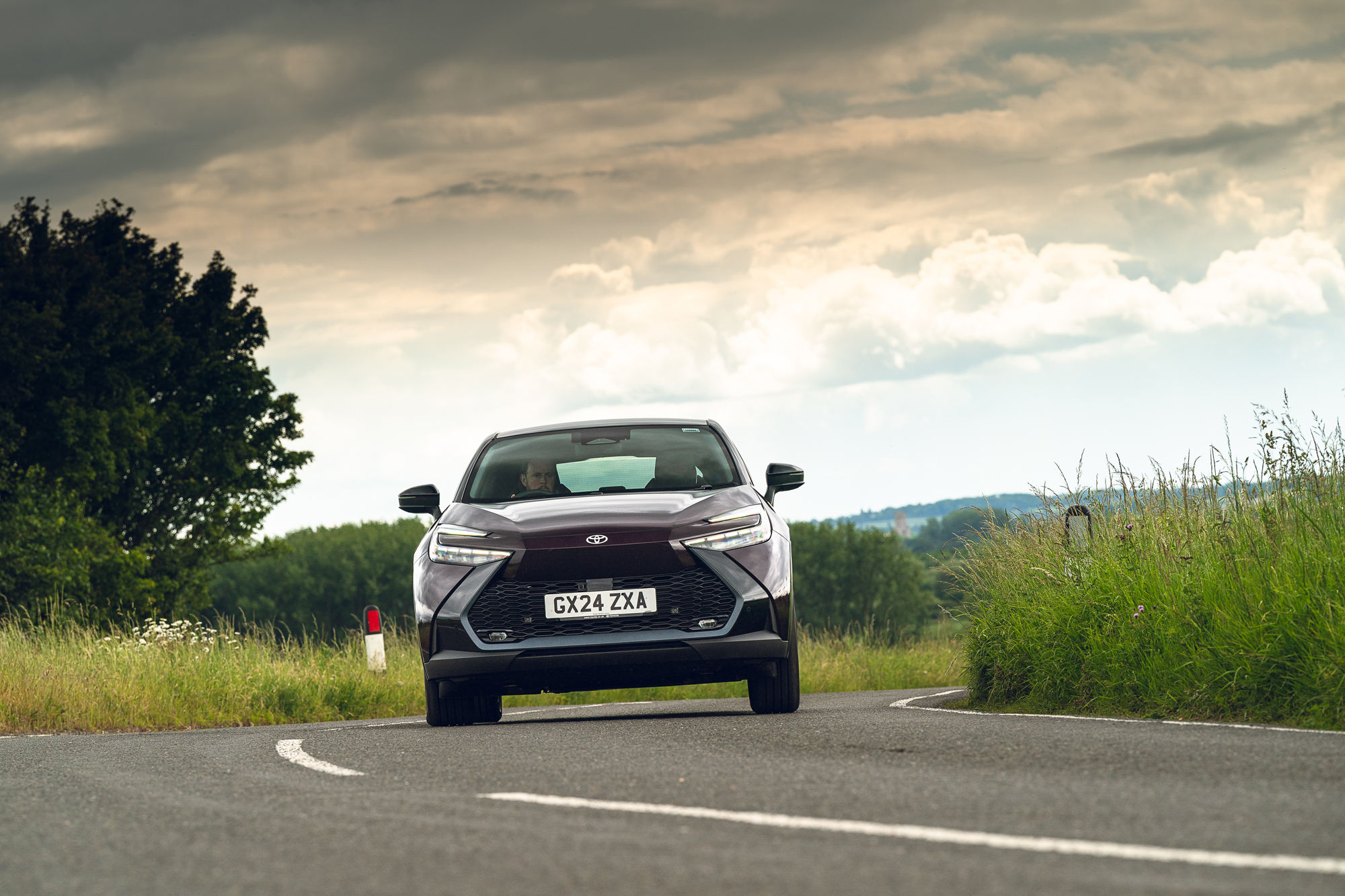
Facts & Figures | Toyota C-HR PHEV
What’s the line-up?
Combine Toyota’s fiendishly clever hybrid system with a bigger battery, and you get a car with a good electric range and impressive efficiency when the charge has gone. The electrical system has also been uprated, bringing an extra 23bhp. So all good under the hood, but – like the 408 – its distinctive styling will limit its usefulness and passenger appeal. That said, the similar-looking previous model was a big seller.
Data
Price £39,145 (£43,615 as tested)
Engine 1987cc four-cylinder
Hybrid system 13.6kWh battery (net), single electric motor, CVT
Performance 220bhp (total system output), 139Ib ft (engine) 153Ib ft (e-motor), 7.4sec 0-62mph, 111mph
Weight 1695kg
Claimed efficiency 353.1mpg, 41-mile range, 19g/km CO2
Tested efficiency 36.1-mile electric range, 53.8mpg (engine only)
Length/width/height 4362/1832/1564mm
Boot capacity 310 litres

Facts & Figures | Volvo XC60 T8
What’s the line-up?
The XC60 is the oldest car in this test. Updates have kept it competitive in terms of range and CO2 output and it still has that simple no-nonsense appeal. There are two PHEVs to pick from, the 345bhp T6 and the 449bhp T8 tested here. You’ll need top Ultra trim for the T8, and that’s £10k more than the cheapest XC60 plug-in. Both are four-wheel drive, with the engine powering the front wheels and the electric motor the rears.
Data
Price £68,385 (£70,525 as tested)
Engine 1969cc turbocharged and supercharged four-cylinder
Hybrid system 14.7kWh battery (net), single electric motor, eight-speed automatic
Performance 449bhp (total system output), 453Ib ft (total system output), 4.6sec 0-62mph, 112mph
Weight 2150kg
Claimed efficiency 201.5-282.1mpg, 40.4-48.5-mile range, 23-32g/km CO2
Tested efficiency 37-mile electric range, 33mpg (engine only)
Length/width/height 4708/2117/1656mm
Boot capacity 483 litres

